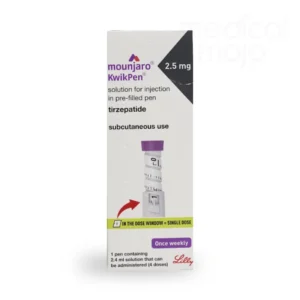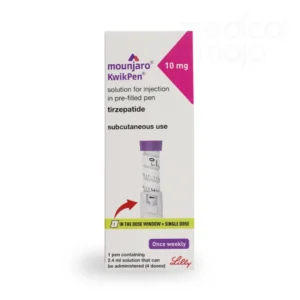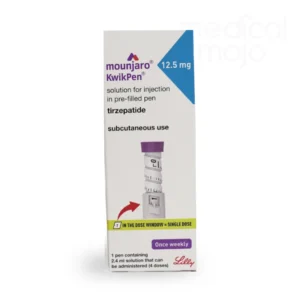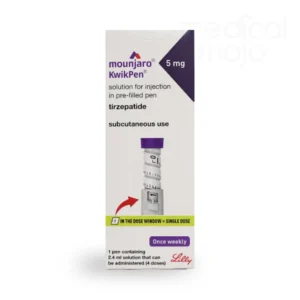Mounjaro is one of the most popular weight loss treatments; it’s the first to combine two gut hormones, GLP-1 and GIP, into one combination weight-loss injection. Its active ingredient, tirzepatide, helps suppress appetite, making it easier to stick to a reduced-calorie diet without constantly feeling hungry. Anyone who has tried to lose weight will know the feeling.
In this blog, we will look at Mounjaro weight loss week by week. The results from the Surmount 1 trial demonstrated that people on the Mounjaro 15mg weekly could lose up to 22.5% of their starting weight after 72 weeks. You will learn what kind of weight loss to expect on a week-by-week basis when taking Mounjaro and get our top tips for weight loss. But remember that everyone is unique and that your experience may differ from the overall snapshot of the kind of weight loss we talk about here.
But before we start, we will go over some basics about Mounjaro.
Table of contents
- What is Mounjaro?
- What strengths of Mounjaro are available?
- Mounjaro dosing schedule
- How effective is Mounjaro?
- Mounjaro weekly weight loss table
- Mounjaro week 1: getting started
- Mounjaro week 2
- Mounjaro weeks 3 and 4
- Mounjaro weeks 5 to 8
- Mounjaro weeks 9 to 12
- Mounjaro week 13 and beyond
- Adjusting your Mounjaro dose
- How much weight can you lose?
- Summary of weight loss by Mounjaro after 72 weeks
- Tips for successful weight loss on Mounjaro
- What to remember when taking Mounjaro
- Buy Mounjaro online
-
 Mounjaro 2.5mg InjectionPrice range: £174.99 through £649.99
Mounjaro 2.5mg InjectionPrice range: £174.99 through £649.99 -
 Mounjaro 10mg InjectionPrice range: £323.75 through £1,265.00
Mounjaro 10mg InjectionPrice range: £323.75 through £1,265.00 -
 Mounjaro 15mg InjectionPrice range: £422.50 through £1,640.00
Mounjaro 15mg InjectionPrice range: £422.50 through £1,640.00
What is Mounjaro?
Mounjaro, the brand name for tirzepatide, is a recently approved weekly weight loss injection. The UK’s Medicines and Healthcare Products Regulatory Agency (MHRA) authorised its use in November 2023. It is licensed for adults with obesity (BMI of 30 or higher) or those who are overweight (BMI 27–30) and have health conditions related to their weight (MHRA 2023).
The active ingredient in Mounjaro, tirzepatide, aids in weight loss by controlling appetite. It helps you feel fuller, reduces hunger, and curbs food cravings (MHRA 2023).
Tirzepatide is the first drug to combine two gut hormones, glucagon-like peptide-1 (GLP-1) and glucose-dependent insulinotropic polypeptide (GIP). These hormones, called incretins, stimulate insulin release in response to food. Since Mounjaro combines both incretins, it is called a “twincretin.” This combination enhances appetite suppression, prolongs feelings of fullness, and slows stomach emptying. When combined, GLP-1 and GIP work more effectively to promote significant weight loss (Coskun T et al., 2018).
Have questions about Mounjaro?
Get a FREE telephone consultation with one of our pharmacists, who will call you and help you understand what the right options are for you.
Call me about Mounjaro
What strengths of Mounjaro are available?
It is administered weekly as a subcutaneous injection, typically in the stomach, thigh, or upper arm.
Mounjaro dosing schedule
- Starting dose: You begin with the Mounjaro 2.5mg dose once a week for the first four weeks.
- Dose increase: After the first four weeks on the Mounjaro 2.5mg, you move to the Mounjaro 5mg injection.
- Further adjustments: If your healthcare provider advises, the dose can be gradually increased at four-week intervals, up to a maximum of Mounjaro 15mg weekly.
This step-by-step increase allows your body to adjust to the medication and reduces the risk of side effects. Studies have shown that most side effects occur during this adjustment phase as the body adapts to Mounjaro (Jastreboff et al., 2022).
How effective is Mounjaro?
A series of large-scale clinical trials called the SURMOUNT trials demonstrated that Mounjaro is effective in causing weight loss in both diabetics and non-diabetics. Here is a quick breakdown of the four SURMOUNT trials.
The SURMOUNT-1 trial
The Surmount 1 trial measured weight loss that could be achieved in non-diabetic patients. Individuals with a body mass index (BMI) of 30 kg/m² or higher, or 27 kg/m² or higher with at least one weight-related condition (e.g., high blood pressure). It ran for 72 weeks and found that at the highest dose of Mounjaro 15mg, participants achieved an average weight loss of up to 22.5% of body weight and nearly 90% of participants achieved at least a 5% weight loss.
These were impressive results, with participants achieving weight reductions of up to 20.9% with the Mounjaro 15mg; compare this to previous FDA and MHRA-approved anti-obesity medications, such as orlistat, which could only achieve weight loss reductions of between 3.0 to 8.6% (American Diabetes Association Professional Practice Committee, 2022). While the more recent GLP-1-based anti-obesity medication, semaglutide, produces weight reductions of 12.4% (Wilding JPH et al., 2021).
The SURMOUNT-2 trial
The Surmount 2 trial studied the weight loss and the blood sugar control effects of tirzepatide in individuals with type 2 diabetes who are also overweight or obese. The trial also ran for 72 weeks and found weight loss on the highest dose of Mounjaro 15mg was 15.6% on average, slightly less than the Surmount 1, but impressive nonetheless. More than 80% of participants achieved at least 5% weight loss and there were slight improvements in sugar levels.
The SURMOUNT-3 trial
The Surmount 3 trial assessed tirzepatide or Mounjaro’s effectiveness in helping adults maintain significant weight loss through structured diet and exercise programs. It ran for 52 weeks and helped 6-10% of participants to sustain and further reduce their weight. The study also noted improvements in other health markers, such as LDL (bad) cholesterol and blood sugar levels.
The SURMOUNT-4 trial
The Surmount 4 trial, which ran for 72 weeks, studied the impact of Mounjaro on individuals with severe obesity. It found that tirzepatide helped participants achieve a staggering weight loss of 24.2% when taken at the Mounjaro 15mg dose, with over 80% of participants achieving more than 15 % weight loss.
These results were unprecedented for a weight loss drug. The most weight loss recorded with a prescription drug was with semaglutide, given at a dose of 2.4mg weekly, which achieved between 9.5 and 15.3kg of weight loss, while tirzepatide or Mounjaro can achieve up to 23.6kg of weight loss (Telci Caklili O et al., 2023). So, we now know that Mounjaro is effective for weight loss, but what kind of weight loss can you achieve week by week?
Mounjaro weekly weight loss table
| Week | Tirzepatide (5mg) | Tirzepatide(10mg) | Tirzepatide (15mg) | Placebo |
| 0 | 105 kg | 105 kg | 105 kg | 105 kg |
| 4 | 101 kg | 100.5 kg | 100 kg | 104.5 kg |
| 8 | 96.5 kg | 95.5 kg | 95 kg | 104 kg |
| 12 | 93.5 kg | 91.5 kg | 90 kg | 103.5 kg |
| 16 | 91.5 kg | 89 kg | 87 kg | 103 kg |
| 24 | 90 kg | 86 kg | 84.5 kg | 102.5 kg |
| 36 | 89.3 kg | 84.5 kg | 83 kg | 102.4 kg |
| 48 | 89 kg | 83.5 kg | 82 kg | 102.4 kg |
| 72 | 88.6 kg | 82.6 kg | 81.2 kg | 102.4 kg |
| Week | Tirzepatide (5mg) | Tirzepatide(10mg) | Tirzepatide (15mg) | Placebo |
| 0 | 231 lbs | 231 lbs | 231 lbs | 231 lbs |
| 4 | 222.2 lbs | 221.3 lbs | 220.5 lbs | 230 lbs |
| 8 | 212.7 lbs | 210.5 lbs | 209.4 lbs | 229 lbs |
| 12 | 206 lbs | 201.6 lbs | 198.4 lbs | 228 lbs |
| 16 | 201.6 lbs | 196.2 lbs | 191.8 lbs | 227 lbs |
| 24 | 198.4 lbs | 189.6 lbs | 186.2 lbs | 226 lbs |
| 36 | 196.8 lbs | 186.3 lbs | 183 lbs | 225.8 lbs |
| 48 | 196.2 lbs | 184 lbs | 180.7 lbs | 225.8 lbs |
| 72 | 195.3 lbs | 182.1 lbs | 179 lbs | 225.8 lbs |
Summary of total weight loss after 72 weeks with Mounjaro
- 5 mg Tirzepatide: 16.4 kg (36.1 lbs)
- 10 mg Tirzepatide: 22.4 kg (49.4 lbs)
- 15 mg Tirzepatide: 23.8 kg (52.5 lbs)
- Placebo: 2.6 kg (5.7 lbs)
Mounjaro week 1: getting started
When beginning Mounjaro, you’ll always start with a 2.5mg dose of tirzepatide, even if you’ve previously taken Mounjaro or other weight loss injections. For example, you can’t jump straight from a high dose of Wegovy to a high dose of Mounjaro because the active ingredients differ. Wegovy contains the GLP-1 RA and semaglutide, while Mounjaro contains tirzepatide, which contains both GLP-1 and GIP. So, because they have different active ingredients, your body may react differently, which is why it is recommended to start at the Mounjaro 2.5mg dose and let your body become accustomed to it. If you’re considering a switch and are unsure about how to do this safely, please contact us for a FREE consultation, and one of our prescribers will guide you through the whole process.
The secret of weight loss with Mounjaro
The secret of weight loss with Mounjaro, in one word, is consistency. So, even before you inject your first dose of Mounjaro 2.5mg, pick a day and time that will be convenient for you to stick to every week. Consistency is key when using Mounjaro because this will allow you to maintain steady tirzepatide levels in your bloodstream and help you reduce the side effects, giving your body time to adjust to the new medication. Remember, failing to plan is planning to fail. Taking a little time out to plan ahead and prepare can set you up for success on your weight loss journey.
What to expect in week 1 on Mounjaro
Don’t expect miracles during your first week; remember, the journey of 1000 miles begins with one step. During your first week on Mounjaro, your weight loss results may vary—you might notice a sudden drop, some loss, or very little change. Studies suggest participants lose just under 1% of their starting weight per week during the first four weeks; for some, this could mean up to 5kg (Jastreboff A. M et al., 2022) (see table above)
If you experience a sudden weight drop, it could be due to losing “water weight.” To explain “water weight,” we need to discuss how the body stores its emergency fuel, glycogen.
When you start losing weight, especially by eating fewer calories than your body needs, your body looks for extra energy to compensate for the deficit. One of the first sources it turns to is glycogen.
What is glycogen?
Glycogen is a type of carbohydrate that your body uses as a quick and easily accessible energy source. It’s made from glucose (sugar) and stored primarily in your liver and muscles (Kanungo S et al., 2018). Think of it as your body’s “emergency energy reserve.” Glycogen is important because it provides energy for your body to function between meals or during exercise.
-
 Mounjaro 12.5mg InjectionPrice range: £422.50 through £1,640.00
Mounjaro 12.5mg InjectionPrice range: £422.50 through £1,640.00 -
 Mounjaro 7.5mg InjectionPrice range: £323.75 through £1,265.00
Mounjaro 7.5mg InjectionPrice range: £323.75 through £1,265.00 -
 Mounjaro 5mg InjectionPrice range: £229.99 through £899.99
Mounjaro 5mg InjectionPrice range: £229.99 through £899.99
How does the body use glycogen during weight loss?
When you’re in a calorie deficit (eating less than your body needs), your blood sugar levels might drop slightly because you consume less food. In response, your body starts breaking down glycogen stores to release glucose into your bloodstream to stabilise your energy levels. This helps power your brain, muscles, and other vital processes.
For every gram of glycogen stored, your body holds onto about 3 grams of water (Olsson et al, 1970). When your body starts using glycogen for energy, it releases this water as well, which is why you might notice a quick drop in weight during the first week of dieting—this is often called “water weight.”
Where is glycogen stored?
- Liver: Glycogen stored in the liver helps maintain blood sugar levels between meals and during fasting.
- Muscles: Glycogen in your muscles mainly provides energy during physical activity.
What happens when glycogen is depleted?
Once your glycogen stores are used up, your body shifts to burning fat for energy. This process is called lipolysis, and it’s the stage where your body starts breaking down fat stores to produce energy, leading to more sustainable fat loss over time.
Why is glycogen important for weight loss?
Understanding glycogen helps explain why weight loss is often more noticeable at the beginning of a diet—your body is using glycogen and losing the water stored with it. However, as your glycogen stores deplete, your body starts relying more on fat for energy, leading to slower but more meaningful weight loss.
This happens because you begin to eat less. You start using your body’s emergency energy store of glycogen, the storage form of glucose in the liver. This occurs in the first week of eating fewer calories as your body taps into stored carbohydrates (glycogen) for energy. Since glycogen binds with water (at least 3g of water per gram of glycogen), releasing it results in fluid loss. You may notice faster results if you’ve made significant lifestyle changes, like adjusting your diet or exercise routine alongside Mounjaro.
After your glycogen stores are depleted, your body begins metabolising fat for energy, meaning fat loss is more likely to occur after the first week.
Remember that everyone’s weight loss journey is unique, and it’s okay if your results take time to show.
In the first few weeks, you may notice subtle changes in your appetite and eating habits. While significant weight loss might not occur immediately, some people experience reduced appetite and fewer food cravings, signalling that Mounjaro is starting to take effect.
With a decreased appetite, you’re likely to eat fewer calories, creating a caloric deficit that sets the foundation for future weight loss. However, it’s important not to skip meals, as your body needs proper fuel to function. Skipping meals can backfire, leading to increased hunger and overeating later in the day.
Side effects and appetite in week 1 on Mounjaro
During this early phase, your body is getting used to Mounjaro, and it’s during these first weeks, you might start to encounter the classic side effects associated with Mounjaro. These include mild gastrointestinal side effects like nausea, constipation, or diarrhoea, which may occur as your body adjusts to the medication. These symptoms are common and should improve with time. In the clinical studies, the adverse effects were mainly seen during these early weeks as the body was getting used to the Mounjaro (Jastreboff A. M et al., 2022).
Can I stay on a lower dose for more than four weeks?
If you are experiencing side effects when you transition to a higher dose, you can remain at the lower dose for a while longer, provided you are losing weight. If you are unsure when to move to the next dose, please contact us for a FREE consultation to get you started on Mounjaro.
Will my appetite start to reduce during the first weeks?
You may be one of the lucky ones who starts to notice that their appetite is decreasing, even when on the lower Mounjaro 2.5mg dose. However, it’s important to remember that this is your adjustment dose that allows your body to get used to Mounjaro. If you start feeling that your appetite is reducing, you have an additional bonus. The main point is not to expect miracles straight away; give the Mounjaro time to work and follow the dose escalation to ensure that you experience minimal side effects.
Medical Mojo top tips for the first weeks on Mounjaro
Use this dose escalation period to start to build healthy habits. Try to eat balanced meals that fall within your daily calorie goals. Make sure you drink plenty of water. Remember, you will lose water along with the stored glycogen, so it is important to stay hydrated. Also, try to incorporate some exercise into your daily routine. When choosing a form of exercise, try to do something you enjoy rather than something you dread. Personally, I hate running, but if I have a wrestling mat and some willing opponents, that will be enough of a workout for me.
Mounjaro week 2
Congratulations! You have completed your first week, and now it’s time for your next injection. Much like week one, don’t expect miracles. You are still on the Mounjaro 2.5mg as part of the dose escalation programme. Use this time to consolidate your health improvement plan and stick to it. Remember that word we mentioned earlier? Consistency. Start making things part of your normal routine, like brushing your teeth in the morning and before bed.
Your body has now had more time to adjust to Mounjaro, and you may start feeling fewer side effects. However, if the side effects are severe or are not starting to subside, contact your doctor or drop us a line, and one of our prescribers will get back to you for a FREE consultation.
Weight loss in week 2 varies from person to person and depends on factors like your body, age, metabolism, and lifestyle choices. Studies suggest that most people lose less than 1% of their body weight per week during the first 4 weeks—typically around 1kg (2.2 pounds) per week, so that by the end of the fourth week, a possible 5kg can be lost (Jastreboff A. M et al., 2022)-see table above.
Is Mounjaro right for you?
Get a FREE telephone consultation with one of our pharmacists.
Call me about Mounjaro
Mounjaro weeks 3 and 4
By weeks 3 and 4, many people find that any side effects they experienced start to improve or disappear. You’ll continue with the Mounjaro 2.5mg dose, and your body should now be adjusting to the treatment.
By the end of week 4, the Surmount 1 trial found that participants lost between 3.8% and 5% of their starting weight. That means if you started off at 105kg, you could expect to lose anything from 4 to 5kg. Of course, this is if you have remained on your new health plan by following a reduced caloric intake and an exercise routine of your choice.
By now, the levels of Mounjaro would have built up in your body; it’s half-life, that’s the time it takes for the levels in the body to reduce by 50%, is about 5 days (Schneck, K et al 2024). By having such a long half-life allows Mounjaro to be taken on a weekly basis. So, once the blood levels have started to creep up, you may notice that you stay fuller for longer and experience less hunger between meals, during which you are probably snacking less.
So, while these first few weeks are a period of adjustment, allowing your body to get used to Mounjaro and the reduced caloric intake, it’s still important to follow a balanced diet. Why? It seems counterintuitive; you take Mounjaro to eat less, right? It’s all about another word: balance. Make sure that you eat a balanced diet that includes all the nutrients you need and has plenty of protein to stop your body from breaking down your muscles as opposed to fat for fuel.
Mounjaro and coenzyme Q10
Fewer calories mean you might become deficient in important nutrients and vitamins. If there is one vitamin you should supplement with, other than vitamin D3 and K2 (wait, that’s two already), it’s Coenzyme Q10. Although not technically a vitamin, since your body can make its own, this vital supplement helps your body produce energy and acts as a powerful antioxidant to mop up those destructive free radicals (Crane FL (2001). To learn more about the amazing benefits of Coenzyme Q10, check out our blogs, such as CoQ10 and fertility.
Mounjaro weeks 5 to 8
Dose Increase: Week 5 marks your first dose increase, moving to Mounjaro 5mg each week. If advised by your healthcare provider, you’ll remain on this dose for at least four weeks (weeks 5 to 8) before considering the next increase in week 9.
Weight Loss: By the end of week 8, the SURMOUNT-1 clinical trial suggests that up to a 10kg or nearly 8.5 to 9.5% weight reduction can be achieved (Jastreboff A. M et al., 2022). See table above.
Weighing yourself while taking Mounjaro
Just a quick word about weighing yourself. It’s better to weigh yourself weekly or even fortnightly rather than become overly obsessed with your bathroom scales on a daily basis. Daily fluctuations in your weight can be misleading, and having a nice surprise on the scales after two weeks is better than daily disappointments.
In addition to the bathroom scales, look for other clues to your weight loss, like your clothes becoming looser or your waist measurements reducing.
Mounjaro 5mg side effects
With the jump in strength from Mounjaro 2.5mg to Mounjaro 5mg, you may experience some side effects that may return as your body adjusts. Common side effects like nausea, constipation, stomach ache, or diarrhoea are usually mild and temporary, lasting a few days to a few weeks.
If side effects are severe or long-lasting, your doctor may recommend staying on Mounjaro 2.5mg for longer before increasing the dose. If bothersome side effects persist beyond 4 weeks on the lowest dose, it may be time to reassess your treatment plan. If this happens to you, contact us for a FREE Mounjaro weight loss consultation.
Mounjaro 5mg appetite changes
OK, we got the bad news about the increased risk of side effects with a jump up in strength; now let’s talk about the good stuff, like your reduced appetite. The higher dose might bring more noticeable changes to your appetite, helping you feel full for longer and making it easier to stick to a reduced-calorie diet.
Lifestyle impact of Mounjaro
After a month of diet and lifestyle adjustments, you may feel more energetic and notice improvements in your overall health. Continue following your meal plans and exercise routine to maintain your progress and support your body as it adjusts to the higher dose over the next few weeks.
Mounjaro weeks 9 to 12
Dose Increase: The beginning of week nine marks another milestone, and it’s time to step up the dose to Mounjaro 7.5mg weekly.
Weight Loss: By the end of week 12, if you started at 105kg, you would now weigh 90kg; that’s a whopping 15kg weight loss or 14.2% weight reduction. Of course, your results may vary from the observations in the Surmount 1 trial, but nonetheless, you should have achieved some noticeable weight reductions.
Side Effects: An increase to Mounjaro 7.5mg may also bring an increase in some of the side effects, but this varies for each person. However, since you now have 8 weeks’ worth of Mounjaro in your system, your body should have learnt to adjust to these side effects. If you typically experience side effects with dose changes, consider these tips to ease discomfort:
- Try small, plain meals to manage nausea.
- Use over-the-counter remedies for diarrhoea, constipation, or acid reflux.
- For the first few days of a dose change, don’t plan anything stressful, and try to get as much rest as possible during the dose change days.
If you’re satisfied with your progress on Mounjaro 5mg and wish to avoid side effects, there’s no obligation to increase your dose. So, as long as you are happy with your weight loss and side effects, you can stay at a lower dose of Mounjaro. If you are unsure about increasing the dose or staying at a lower dose, contact us for a FREE Mounjaro weight loss consultation.
Medication Effect: You might notice enhanced effects at the higher Mounjaro 7.5mg dose, such as reduced hunger and feeling fuller for longer between meals. Use this as an opportunity to stay consistent with your diet and lifestyle goals and avoid bad habits.
Mounjaro week 13 and beyond
Dose Increase: Starting in week 13, you can transition to the weekly Mounjaro 10mg injection, or if you are happy with the Mounjaro 7.5mg weight loss effects, you can stay on the lower dose for a while longer.
Weight Loss: By the end of week 16, research from the Surmount 1 trial suggests you may have lost approximately 17% of your starting weight. So, if you started the Mounjaro weight loss regimen with a weight of 105kg, you should now weigh 87kg. Again, results will vary individually, but as long as you’re steadily losing weight and the combination of medication and lifestyle changes is working, don’t worry if your progress is slightly slower.
Side Effects: You know the drill by now. A dose increase has the potential for more side effects, so it’s always best to plan the dose increases on stress-free days when you have the opportunity to rest. Be prepared to manage mild symptoms like nausea, constipation, or diarrhoea with over-the-counter treatments if needed. If you need any further advice on how to deal with the Mounjaro side effects, please contact us for your FREE Mounjaro weight loss consultation.
Medication Effect: At the Mounjaro 10mg dose, appetite suppression should improve further, making it easier to maintain a reduced-calorie diet. While you may still experience occasional hunger, it should be more manageable compared to not taking Mounjaro.
Adjusting your Mounjaro dose
According to the Mounjaro dosage schedule, you’ll gradually increase your dose by 2.5mg every 4 weeks, reaching the maximum maintenance dose of Mounjaro 15mg by week 21. However, this timeline can be extended if you choose to stay on a lower dose longer. When you’re ready, you can increase your dose at your own pace. If you need more advice or are unsure when to change your dose, please contact Medical Mojo for your FREE Mounjaro weight loss consultation.
How much weight can you lose?
Slow and steady wins the race; remember the hare and the tortoise? Mounjaro is designed as a long-term treatment for obesity and is meant to be paired with sustainable diet and exercise changes. This approach helps you lose weight and maintain your progress over time. The Surmount 1 trial shows that the most effective weight loss results occur after 72 weeks of treatment with up to 22.6% weight reduction, or to put it another way, if you started Mounjaro weighing 105kg, you would now weigh 81.2kg, a loss of 23.8kg.
In the studies, participants followed maintenance doses of 5mg, 10mg, or 15mg, but you can stay on a dose that works best for you. By week 72, the average weight loss for a starting weight of 105kg was:
Summary of weight loss by Mounjaro after 72 weeks
- 5 mg Tirzepatide: 16.4 kg (36.1 lbs) or 15.6%
- 10 mg Tirzepatide: 22.4 kg (49.4 lbs) or 21.3%
- 15 mg Tirzepatide: 23.8 kg (52.5 lbs) or 22.6%
The majority of participants (89.4% to 96.3%) lost at least 5% of their starting weight, depending on their maintenance dose.
Your doctor will monitor your progress to ensure you lose at least 5% of your starting weight within 12 weeks of starting your chosen Mounjaro maintenance dose. If this goal isn’t met, they may recommend a different treatment or provide additional guidance to improve your diet and lifestyle habits.
Tips for successful weight loss on Mounjaro
Here’s how to maximize your weight loss journey with Mounjaro:
1. Achieve a 600-calorie deficit
Aim for a daily calorie deficit of around 600 calories to lose weight effectively compared to your recommended intake (this varies for men and women). Mounjaro helps by reducing hunger and increasing feelings of fullness, making it easier to eat less. If cutting calories feels challenging, try a gradual approach—start by reducing 100 calories a week until you reach your goal. Using a calorie-tracking app can also help.
2. Eat a balanced diet
Focus on balanced, healthy meals. Limit or avoid high-fat, sugary, processed, or calorie-dense foods. Stick to whole foods like fruits, vegetables, lean proteins, and whole grains. For balance, include small amounts of healthy fats, such as nuts, seeds, and olive oil. Try to increase your protein intake to prevent your body from breaking down your muscles as opposed to fat for fuel. If you want to know if you can drink alcohol with Mounjaro, head over to Mojo Guide for loads of evidence-based articles.
3. Try to exercise regularly
Try to start exercising regularly, choose something you enjoy and don’t dread. So long as you are moving, being active, and not expecting Mounjaro to do all the heavy lifting for weight loss. For guidance on what exercise to choose, have a read of the NHS’s guidance, Physical activity guidelines for adults aged 19 to 64.
4. Prioritise sleep
Try to get at least 8 hours of sleep a night. I know it’s easier said than done! If you are having trouble sleeping, why not read our blog on Fifteen tips for healthy sleep? If you have trouble drifting off, listen to our ASMR podcast on our blog, What is ASMR, and can it help you sleep? Als,o if you suffer from sleep apnoea, you might find our blog on tirzepatide and sleep apnoea interesting.
If you want to know the secret of weight loss, aside from eating less and moving more, which I think should be self-explanatory, it’s sleep. Getting enough sleep recharges the body, making us wake up refreshed and full of energy, so there is less chance of snacking during the day.
Consistently getting less than 6 hours of sleep per night has been linked to higher body weight and BMI (Knutson K.L et al., 2008). Sleep restriction for just 5 days can cause short-term weight gain, and research suggests that both adults and children who sleep less are more likely to gain weight over time (McNeil J et al., 2017). So, as you can see, sleep is the secret sauce for weight loss. Poor sleep can lead to cravings and low energy, while quality rest supports better food choices and activity levels.
What to remember when taking Mounjaro
We have two key words to remember: consistency and balance. You need to be consistent and remember that it’s a marathon, not a sprint. The most impressive weight loss results observed in the Surmount 1 trial were after 72 weeks.
The other word is balance. Yes, you may be eating less, but you still need to make sure you have a balanced diet. This ensures your body gets the proteins, vitamins, and minerals it needs to operate optimally.
So, be the tortoise and not the hare for long-lasting, sustainable weight loss. For more advice, contact Medical Mojo for your FREE Mounjaro weight loss consultation.
Buy Mounjaro online
Looking to buy Mounjaro online? Medical Mojo offers a convenient and secure way to purchase Mounjaro, with expert advice and fast delivery to support your health needs. Start your Mounjaro journey today by completing our online questionnaire.
Are weight loss treatments making you tired, or have they led to a sudden increase in hair loss? Do you struggle with sleep?
Get a free month’s supply of one of our compounded treatments for energy, hair loss or sleep, with your first purchase of Mounjaro or Wegovy from Medical Mojo.
Claim your FREE offer
Note: This information is for educational purposes only and should not substitute for professional medical advice.
References
- American Diabetes Association Professional Practice Committee, 2022. 8. Obesity and weight management for the prevention and treatment of type 2 diabetes: standards of medical care in diabetes-2022. Diabetes care, 45(Suppl 1), pp.S113-S124.
- Coskun T, Sloop KW, Loghin C, Alsina-Fernandez J, Urva S, Bokvist KB, et al. LY3298176, a novel dual GIP and GLP-1 receptor agonist for the treatment of type 2 diabetes mellitus: from discovery to clinical proof of concept. Mol Metab. 2018;18:3–14. doi: 10.1016/j.molmet.2018.09.009.
- Crane FL (2001) Biochemical functions of coenzyme Q10. J. Am. Coll. Nutr. 20, 591–598.
- Jastreboff, A.M., Aronne, L.J., Ahmad, N.N., Wharton, S., Connery, L., Alves, B., Kiyosue, A., Zhang, S., Liu, B., Bunck, M.C. and Stefanski, A., 2022. Tirzepatide once weekly for the treatment of obesity. New England Journal of Medicine, 387(3), pp.205-216.
- Kanungo S, Wells K, Tribett T, El-Gharbawy A. Glycogen metabolism and glycogen storage disorders. Ann Transl Med. 2018 Dec;6(24):474.
- Knutson K.L., Van Cauter E. Associations between Sleep Loss and Increased Risk of Obesity and Diabetes. Ann. New York Acad. Sci. 2008;1129:287–304.
- McNeil J., St-Onge M.P. Increased Energy Intake Following Sleep Restriction in Men and Women: A One-Size-Fits-All Conclusion? Obesity. 2017;25:989–992.
- MHRA, 2023. MHRA authorises diabetes drug Mounjaro (tirzepatide) for weight management and weight loss. GOV.UK. Available at: https://www.gov.uk/government/news/mhra-authorises-diabetes-drug-mounjaro-tirzepatide-for-weight-management-and-weight-loss [Accessed 30 Nov. 2024].
- Olsson, K. E., & Saltin, B. (1970). Variation in total body water with muscle glycogen changes in man. Acta Physiologica Scandinavica, 80(1), 11–18. doi:10.1111/j.1748-1716.1970.tb04764.x
- Schneck, K. and Urva, S., 2024. Population pharmacokinetics of the GIP/GLP receptor agonist tirzepatide. CPT: Pharmacometrics & Systems Pharmacology, 13(3), pp.494-503.
- Telci Caklili O, Cesur M, Mikhailidis DP, Rizzo M. Novel Anti-obesity Therapies and their Different Effects and Safety Profiles: A Critical Overview. Diabetes Metab Syndr Obes. 2023 Jun 14;16:1767-1774.
- Wilding JPH, Batterham RL, Calanna S, et al. Once-weekly semaglutide in adults with overweight or obesity. N Engl J Med 2021;384:989-1002


